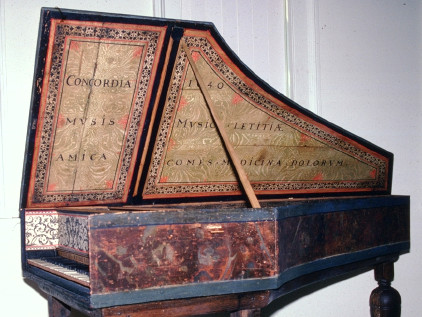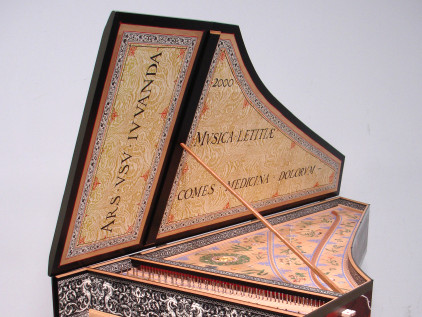Technical Library
DECORATION X: Latin Mottos
Entire Contents Copyright © 2020 CBHTechnical LibraryDECORATION X: Latin Mottos Entire Contents Copyright © 2020 CBH |
 CAREY BEEBE |
 |
|
| 1640 Andreas Ruckers, Yale University Collection of Musical Instruments | Traditionally decorated Flemish lid with Latin mottos |
Latin mottos…
Working from the outside of the lid, the original Flemish decoration scheme had a band of painted black and another of varnished wood (imitating gold), before the printed border papers and the central expanse of moiré (imitation ashgrain) papers. A simpler, modern scheme might dispense with the black and varnish, substituting a single painted band of the case exterior color to butt against the border papers.
The lid interiors of many of the original Flemish instruments had mottos in Latin, lettered in bold black Roman upper case on the moiré papers after the papers were glued to the lid and flap. Thomas McGeary made a thorough study (AMIS vol vii 1981) of the mottos both occurring on original instruments, and presumed to occur because of iconographical evidence, mostly from surviving paintings. A list of mottos used only on Ruckers instruments was published in Grant O’Brien’s 1990 book for Cambridge University Press, Ruckers — A harpsichord and virginal building tradition, and various other references can be found.
One of the most frequently-asked questions at concerts is what the mottos actually mean. To fit nicely on the instrument, many of the mottos were truncated versions of much older conceits or biblical references, so knowing a little Latin is not necessarily enough to coherently grasp the idea of some.
There are several considerations involved for choice of motto, not just the philosophy itself. The shorter three- or four-word mottos are suitable for the flap. If there is a long word in the motto, the flap can be lettered sideways and therefore two short lines could even be accommodated on a double-manual instrument.
There should be three lettered lines on the main lid for good balance: The date can appear in the first line occupying the small area in the cheek/bentside corner, especially if the choice of lid motto begins with a long first word and so can only be fitted in two remaining lines with the final line longest. Other mottos might split nicely into two lines for the main part of the harpsichord lid—or the lid of a virginal. Blank space at the ends of lines can be filled with an ornament if necessary.
In the spirit of the earlier schemes, most makers today tend to use larger letter size because most modern instruments have larger musical compass than when the originals left the Ruckers atelier. Also, modern taste dictates that the lettering be executed far neater than before. If you were working to deceive, you would imitate the original lettering which was often poorly spaced and becoming increasingly crowded at the ends of lines.
After the mottos are lettered, red lines are painted over the joins between the various bands made by the decoration. A line of black is drawn on the moiré papers themselves, just inside the border papers, and red arabesque explosions fill the corners and punctuate the sides.
Of course, anything is possible in the spirit of things, and one interesting variation was the Flemish Double harpsichord built in 1990 by my San Francisco friend and colleague Kevin Fryer. It was commissioned by the late Laurette Golderg, founder of MusicSources. Proud of her Jewish heritage, Laurette chose Hebrew texts for the inside of her harpsichord lid. It is one of the instruments we have often used at Carmel Bach Festival, where it was lovingly nicknamed the ”Hebrewchord” by the crew.
Here are a list of some of the mottoes we’ve used over the years. Of course, you could also make up your own: Maybe not Hello, sailor! New in town? but something tastefully displaying some of your thoughts. Mottos marked by † in the list below don’t appear on surviving original instruments or iconography, but were chosen specially by our customers to reflect their own particular philosophies.
| Deeds prove the man | ACTA VIRUM PROBANT | |
| Born for greater things | † | AD MAIORA NATUS |
| Art has no enemy but an ignorant man | ARS NON HABET INIMICUM NISI IGNORANTEM |
|
| Art must be aided by practice | ARS USU JUVANDA | |
| Listen, watch and be silent if you wish to live in peace | AUDI VIDE ET TACE SI VIS VIVERE IN PACE |
|
| Harmony is a friend to the Muses | CONCORDIA MUSIS AMICA | |
| To God, for country, and for learning. |
† | DEO |
| Sweet song refreshes sad hearts | DULCISONUM REFICIT TRISTIA CORDA MELOS |
|
| To Him be praise with strings and song | † | EUM LAUDATE CHORDIS ET CANTICIS LÆTIS |
| Let us therefore rejoice While we are young |
† | GAUDEAMUS IGITUR JUVENES DUM SUMUS |
| My soul magnifies the Lord and my spirit rejoices in God my saviour | † | MAGNIFICAT ANIMA MEA DOMINUM ET EXULTAVIT SPIRITUS MEUS |
| Music is the companion of joy, the medicine of sorrows | MUSICA LETITIÆ COMES MEDICINA DOLORUM |
|
| Music is the sweet consolation of great labors | MUSICA MAGNORUM SOLAMEN DULCE LABORUM |
|
| Music dispels cares | MUSICA PELLIT CURAS | |
| Nature, the mistress of art | † | NATURA ARTIS MAGISTRA |
| There’s no life better than a good life | † | NULLA VITA MELIOR QUAM BONA |
| Glory be to God alone | SOLI DEO GLORIA | |
| Life is short; art is long (lived) | VITA BREVIS ARS LONGA |
| Technical Library overview | |
| Harpsichords Australia Home Page |